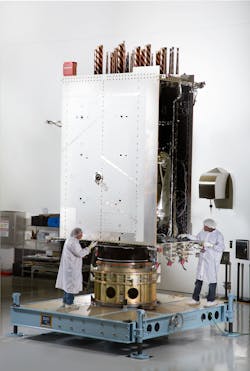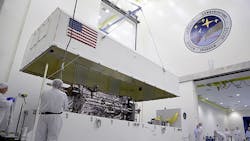GPS III Navigation Payload Moves Forward with Low-Weight Triplexer Contract
The Global Positioning System (GPS) satellite network is preparing for a major overhaul that will enhance its navigation, timing, and position capabilities both for civilian and military users. The Air Force Research Laboratory (AFRL), which is leading the GPS technology development program, has granted a contract to NuWaves Engineering to develop an advanced triplexer for the navigational payload of the new GPS III satellites.
NuWaves, which supplies RF and microwave components to the Department of Defense (DoD) and commercial satellite companies, recently received an extension on its Small Business Innovation Research (SBIR) contract, which was originally issued last year. The company completed the first phase of the contract with support from Exelis Geospatial Systems’ Positioning, Navigation and Timing division, and will again work with Exelis engineers on the triplexer project.
The contract entails the design and testing of a new broadband triplexer that not only exhibits high-power handling but also delivers low insertion losses over the L-band—the primary spectrum range for GPS carriers. The NuWaves and Exelis team will also incorporate advanced filtering and cross-coupling technologies to minimize loss and maximize bandwidth, while also maintaining high isolation between channels.
The triplexer project builds upon NuWaves’ research under the first phase of the contract. The team proposed a method to significantly reduce the size and weight of multiplexers—diplexers, triplexers, and quadplexers—for multi-carrier radio frequency (RF) signal transmission. The project was targeting “a significant reduction in the GPS III satellite’s launch weight, reducing cost to orbit,” according to Jeff Wells, president of NuWaves.
To that end, NuWaves developed a prototype of a GPS L1-band cavity filter and subjected it to a series of multipaction tests. The approach involved using specialized inserts within the filter cavities, resulting in a design that supports wider bandwidths and high signal power levels. The results of the research project are guiding the design of the new triplexer, according to a statement from NuWaves.
The attempt to reduce the size and weight of the navigational payload aligns with the AFRL’s broader development program. Based out of the Wright-Patterson Air Force Base in Ohio, the AFRL program is focused on exploring advanced L-band signal options and manufacturing components that reduce the size, weight, power, and cost of the GPS satellite payload. According to Colonel David Goldstein, director of the AFRL’s space vehicles directorate, the laboratory has thus far targeted new L-band antenna concepts, gallium-nitride (GaN) amplifiers, on-orbit waveform generators, and signal combining methods.
For Exelis, which was acquired by Harris Corp. earlier this year, the triplexer project is simply a footnote to its long history with the GPS satellite constellation. Joe Rambala, vice president and general manager of the GPS division at Harris Corp., notes that the company has built technology for every GPS navigation payload ever launched. According to recent reports, Harris is competing for a new series of contracts that will be issued next year, once the Air Force determines whether subsequent GPS III satellites will have a fully digital navigational payload.
The fully digital payloads, however, will not make it onto the first eight GPS III satellites, which Lockheed Martin is building under contract at its GPS III Processing Facility near Denver, Colo. The evolution of the GPS constellation is being led by the Global Positioning Systems Directorate at the U.S. Air Force Space and Missile Systems Center. Lockheed Martin says that the GPS III satellites will deliver signals that are three times more accurate than the aging Block IIF satellites, assimilating legacy signals from the current satellite network and new types of signals. These include the jam-resistant military M-code and civil signals such as L1C, L2C, and L5.
The GPS III satellites were originally scheduled for launch in 2014, but significant delays have pushed back this timescale to around 2017. According to Rambala, the AFRL has given out L-band contracts to Ball, Boeing, and Northrop Grumman, in addition to Exelis and NuWaves. Lockheed Martin’s website notes that the GPS III satellites will have an operational life of longer than 15 years—about 25% longer than the latest Block IIF vehicles.
About the Author

James Morra
Senior Editor
James Morra is the senior editor for Electronic Design, covering the semiconductor industry and new technology trends, with a focus on power electronics and power management. He also reports on the business behind electrical engineering, including the electronics supply chain. He joined Electronic Design in 2015 and is based in Chicago, Illinois.

